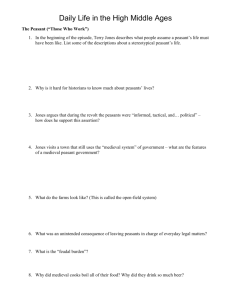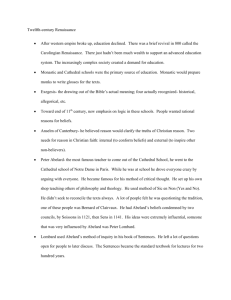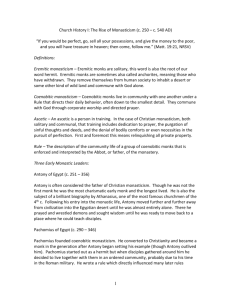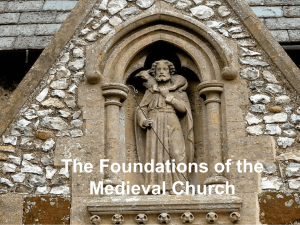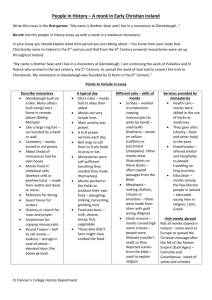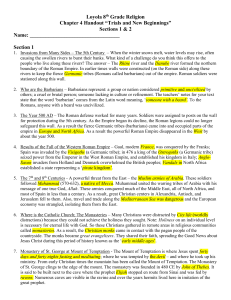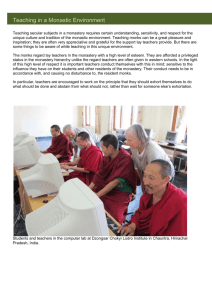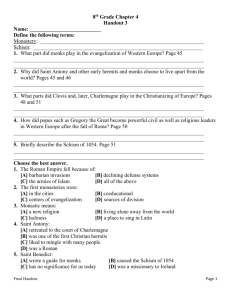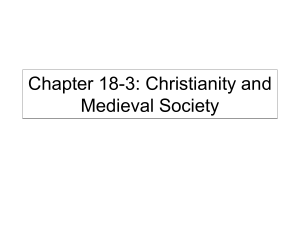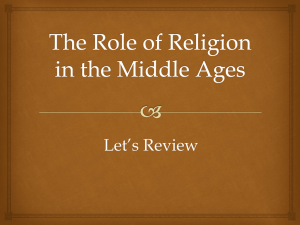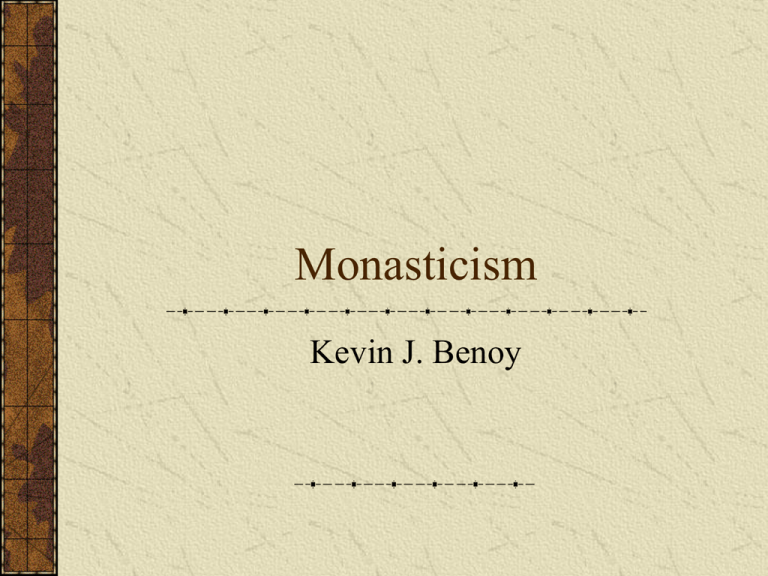
Monasticism
Kevin J. Benoy
Monasticism
The word comes from the Greek word
monos, meaning alone.
The earliest monks were men who left their
homes to be alone in remote places.
Origins
In the late Roman period.
Many religious-minded
people abandoned
“civilization” to go into
the wilderness or deserts
to be closer to God.
This deliberate
abandonment of worldly
temptations is known as
asceticism.
Origins
As individuals and as
small groups, these
monks often sought
out remote locations.
They did this to be
away from the
temptations of the
world and away from
marauding German
tribes.
Irish monastic oratory
Origins
Individuals were
called hermits; they
lived in a place called
a hermitage..
However, not all
monks wanted to live
alone.
Origins
Many chose to
live with others
in religious
communities
called
monasteries..
St. Catherine, Early monastery in the
Sinai Peninsula
Origins
These early monks
turned away from
“normal life”:
They prayed often.
They became chaste.
They fasted.
They gave up their
worldly goods.
Origins
Saint Anthony the
Great was the first to
organize a monastery.
Soon there were many
monasteries in Egypt.
Origins
However, it was St.
Benedict of Nursia
who brought monastic
life to the West.
He established his
monastery in Italy, at
Monte Cassino.
Origins
Benedict’s sister,
Scholastica, founded
convents for women
which gave women the
opportunity of a monastic
life.
Women who lived in
convents were called nuns.
Spreading the Faith
Monks helped make
the medieval world
more orderly
Risking their lives,
they set out to convert
the barbarians to
Christianity.
Spreading the Faith
Famous monks who
took Christianity to
the pagans included
Cyril and Methodius
in the East and Saint
Patrick in the West.
Rule of St. Benedict
Saint Benedict contributed
a book of rules that was
accepted as the way
western monks should live
to the present day.
It provided a life of “pax,
ora et labora” (peace,
prayer and work).
Rule of St. Benedict
The rule saw monastic life as a family.
The abott was seen as the father.
The monks were brothers.
Each day was divided into units of:
Group prayer
Private prayer
Sleep
Ritual reading
Manual labour
The Horarium
Services took place
throughout the day
and at night.
Between these
services there were
times to sleep, eat and
work.
The Church & Cloister
At the heart of every monastery lay both a
church for communal prayer, and a cloister
for individual meditation and prayer.
A Monk’s Life
Monks vowed to
observe:
Poverty – they would
own nothing.
Obedience – they
would follow the
directions of their
abbott.
Out of obedience also
came a commitment to
Chastity – avoiding
sex.
A Life of Prayer
Monks spent a good
part of their life in
prayer – both public
and private.
Gloucester Cathedral Cloister
Public prayer involved
going to church 8 times
a day– in addition to
their work routine.
Private prayer
happened during work
or in the few quiet
moments a monk might
enjoy.
A Life of Quiet Meditation
At meals, monks
ate silently, while
listening to
readings from the
Rule of St.
Benedict.
A Life of Work
Monks worked at a
wide range of
activities:
They farmed the land.
A Life of Work
They cared for the
sick.
Hospital of St. Mary
Magdalene, Stourbridge,
England
A Life of Work
They cultivated herbs
for medicinal use.
A recreated 12th century herb
garden in Cheshire, England
A Life of Work
They cared for the
needy.
Hospital of St. Cross,
Winchester, England. Where
the poor came to be fed in the
Hundred Men’s Hall.
A Life of Work
They preserved
knowledge by copying
books.
Some say they saved
civilization itself in
Western Europe by
preserving what little
learning remained
from the classical
world.
A Life of Work
They taught.
Young clergymen were
taught at their schools.
The first universities
were run by monks.
A Life of Work
Some even fought.
The Knights Templar
were an order of
fighting monks,
dedicated to
conquering and
holding the Holy Land
for Christianity.
Experimentation
Because a monastery
could rely on its
fellow monasteries for
support, it was
possible to
experiment.
New farming
techniques, equipment
and products were the
result and knowledge
was shared with
others.
Experimentation
Monks produced large
quantities of wine, for
sacramental and other
uses.
A Monk, Dom
Perignon, is credited
with inventing
Champagne.
Crop Rotation
The three-field system
probably originated on
a monastic farm
Land would be divided
into thirds. One third
would have one crop,
another third a second,
and the last third would
be fallow. Over three
years the crops and
fallow land rotated.
The Medieval Heavy Plow
The combination of education, farming knowledge
and shared risk helped to spark medieval invention.
Nailed horseshoes and horse-collars made it possible to
replace slow oxen with plough horses, capable of much
more work.
Monastic Expansion
Monasteries were very
successful.
As more people joined
them, they established
new abbeys that were
connected to others of
the same order.
This allowed a sharing
of resources and of
skills and information.
Architecture
Medieval monastic orders,
like the Benedictines,
Augustinians, Cluniacs
and Cistercians generated
great wealth which they
used to build impressive
buildings to the glory of
their God.
Canterbury Cathedral
Gloucester Cathedral
Monastic Wealth
Two orders came to
dominate the Christian
West – the Cluniacs
and the Cistercians.
Cluny III – Central church of
the Cluniacs
Cluniacs
The Cluniacs built
beautiful abbeys and
decorated them with
gorgeous stained glass
and magnificent
ornaments.
A Cluniac, Abbott
Suger, invented the
Gothic form in
architecture.
Cistercians
The Cistercians
resented the Cluniac’s
show of wealth and
built grand, but
unadorned abbeys.
They dominated the
wool trade.
Cistercians at prayer
Other Monastic Orders
New monastic orders assumed
new roles. In Britain alone,
there were 11 groups operating.
Augustinians
Benedictines
Carmelites
Carthusians
Cistercians
Cluniacs
Dominicans
Franciscans
Gilbertines
Premonstratensians
Tironensians
All follow the Rule of St.
Benedict.
Conclusions
Monasticism was a vital
feature of medieval life.
Monks preserved and
extended knowledge.
They provided what little
social welfare was
available.
They created wealth and
helped make the height of
medieval civilization
possible.

